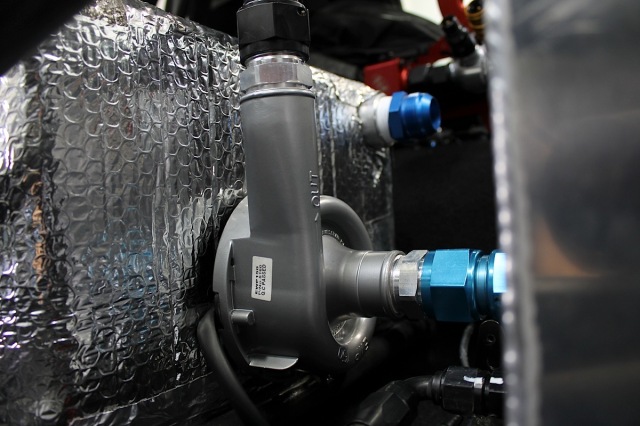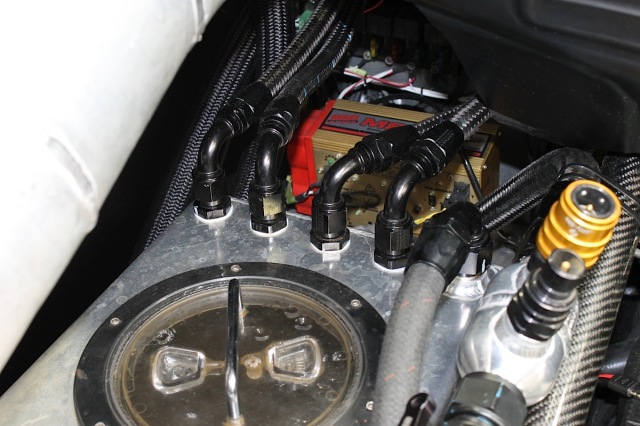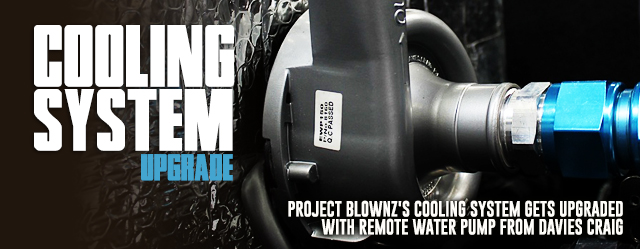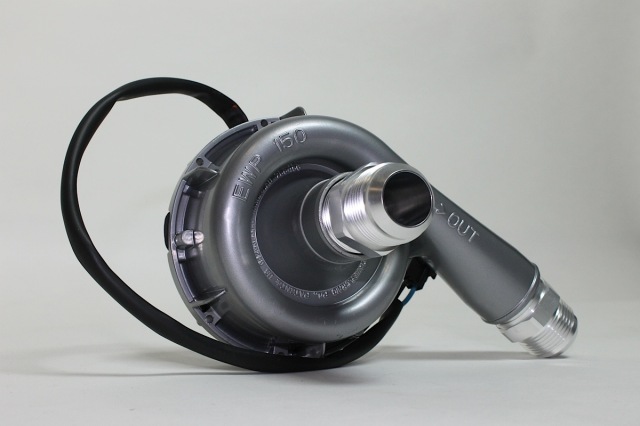If you’ve been following along with our Project BlownZ race car for the last few years, you’ve seen it progress into a 200mph-capable racecar that runs at the front of the pack no matter where it competes – NMCA West, PSCA, and the WCHRA sanctioning bodies here on the West Coast. The car is based around a chassis from PMR Race Cars and a serious 400 cubic-inch LSX engine from Late Model Engines. The powerplant is pumped up by a ProCharger F-1X-12 supercharger making plenty of boost, which requires a lot of cool water running through the engine to control unwanted detonation and keep the cylinders — and cylinder heads — cool.
We recently updated the engine’s cooling system with one of Davies Craig‘s EWP150 remote water pumps [PN 8060], which offers a number of features designed to do exactly what we need. Prior to installation, we removed the old-school bilge pump (designed for a boat) that was previously in its place, and added a trick feature by plumbing the cylinder heads for cool water as well, taking another step to keep the engine as cool as possible during the taxing quarter-mile blasts.
 The EWP150 pump offered by Davies Craig is a universal-fit water pump that’s powered by the car’s electrical system, and are designed to eliminate heat soak and provide better temperature control, critical in our application. Since the pump is wired into our switch panel, operation is easy — and we can turn it on with the car not running to circulate the water/ice mixture throughout the system. The 150 liter-per-minute flow (40 gallons per minute) the pump offers is paramount to the system’s performance, and it’s more effective with any kind of backpressure.
The EWP150 pump offered by Davies Craig is a universal-fit water pump that’s powered by the car’s electrical system, and are designed to eliminate heat soak and provide better temperature control, critical in our application. Since the pump is wired into our switch panel, operation is easy — and we can turn it on with the car not running to circulate the water/ice mixture throughout the system. The 150 liter-per-minute flow (40 gallons per minute) the pump offers is paramount to the system’s performance, and it’s more effective with any kind of backpressure.
According to Davies Craig’s Josh Backes, “Efficiency is key — the design of the pump and the high-efficiency Panasonic motor only draw 10 amps of electrical power. The motor is set into the pump body so that the coolant of the engine keeps the electric motor cool. It also has a double seal to keep the water in the pump. It only weighs 2.5 pounds, and can even be hung off the bottom radiator hose in a street application. We also offer a controller that will bring the draw down to 7-8 amps.”
In order to plumb the water system, we turned to Russell Performance and Peterson Fluid Systems to do so. Russell set us up with some of their ProClassic II -16AN, -10AN and -06AN nylon fiber braided hose along with the correct fittings we required to get the water from our in-car cooling tank to the engine and back again. Peterson’s billet five-way manifolds and Y-blocks made the process simple, even though it might sound complex.
(Left) Peterson Fluid Systems' billet five-way manifolds and a complete assortment of fittings and hose from Russell Performance came in handy when plumbing our system. (Right) Seen here is the tight space we had to work with -- the pump tucks right in and has cured our previous hot-spotting issues in the engine.
The way we have the system routed, there’s an in-car water holding tank that gets chilled between rounds. The EWP150 is mounted to the side of the tank, then -16AN hose is run to the front of the car from the pump, where it is split with a single five-way manifold that uses a -16AN inlet and four -10AN outlets. From there, two of the -10 outlets run to the factory water inlets on the front of the block, and the other two -10 outlets run to yet another pair of five-way manifolds, this time with -10AN inlets and -6AN outlets.
This allows us to get cool, fresh water to each of the eight cylinders, and then the system is routed back to the tank from the factory outlets on the front of the engine block. There’s no radiator in the system — all of the cooling water is run through the holding tank on the inside of the car, which helps to also isolate it from the engine’s heat. The pump’s patented volume chamber eliminates any cavitation in the cooling system, making it less likely to develop heat spikes and hot spots in the engine during operation — one of the main reasons we chose to use it.
The water pump and cooling system upgrade proved to be a simple way to ensure trouble-free cooling system performance, and since the pump is wired into the car’s electrical system, we can run it in the pits between rounds in conjunction with the chiller we picked up from Concato Racing (you can read that article here).

The water returns back to our holding tank to be recirculated during the run, and we hook it up to our Concato Racing chiller between passes to cool the engine down.





















